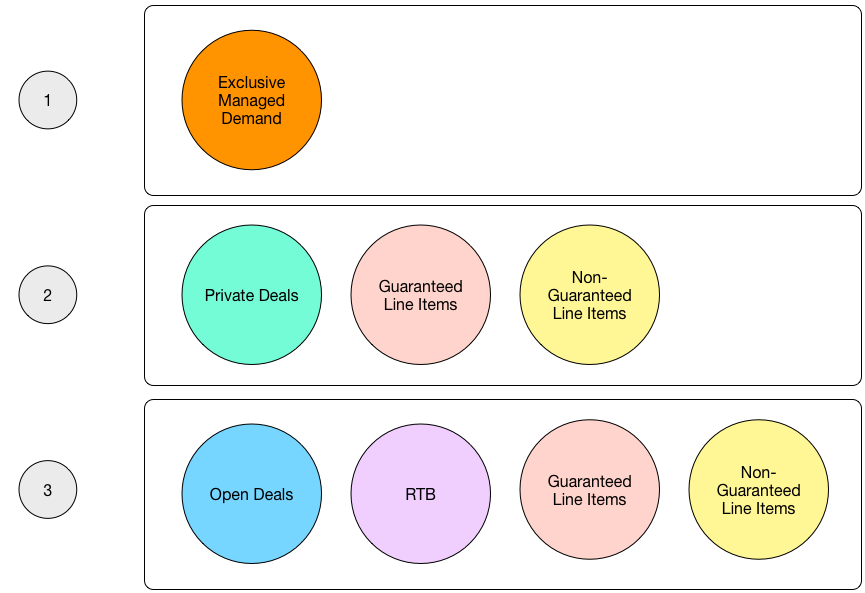Guaranteed delivery auction mechanics
Important
This option is available only to Microsoft Advertising Ad Server customers.
This page describes how auctions involving guaranteed line items work. If you are looking for information about how guaranteed line item pacing and delivery works, see Guaranteed Delivery Pacing. If you need an introduction to what guaranteed line items are and how they work at a high level, Guaranteed Delivery.
How guaranteed delivery auctions work
When guaranteed line items are eligible to bid on an impression, the auction works as follows:
- The ImpBus sends a bid request to the Bidder.
- When the Bidder receives the bid request, it prepares to respond with - at most - one guaranteed bid and up to 14 non-guaranteed bids.
- The Bidder ranks the guaranteed bids against each other according to their priority, and chooses one guaranteed bid to send to the ImpBus. If two guaranteed bids have the same priority, they will be compared to see which line item is further from its goal. The bid whose line item is furthest from goal is much more likely to serve. Which bid is selected is not strictly based on distance from goal; there is a weighted rotation established where line items further from goal are assigned a higher relative weight.
- If the selected guaranteed bid is of the "Exclusive" Delivery Type, only the guaranteed bid is sent to the ImpBus, where it will serve without any competition from other bids.
- If the guaranteed bid is of "Impressions" Delivery Type, the Bidder sends at most one guaranteed bid plus up to 14 non-guaranteed bids. The Bidder calculates a pCPM (priority CPM) to allow the guaranteed bid to compete with other bids (including RTB) in the auction held by the ImpBus. The pCPM value represents the risk that the line item will not deliver in full. The "risk" is defined by considering factors such as pace towards goal and scarcity of inventory. Themore "at risk" the line item is of not achieving its goal, the higher the pCPM value will be.
For information about how to set your reselling priority, see Bidding Priority. For information on how guaranteed and standard line items compete based on priority, see Open Dynamic Allocation and Flexible Priorities.
Price reduction and bid ranking
Guaranteed line items have the following behavior during the price reduction and bid ranking steps (which occur in the Imp Bus):
- When a guaranteed line item with a pCPM value is ranked second to a winning RTB bid, the RTB bid should price reduce to the pCPM value of the guaranteed line item, even if pCPM is below the guaranteed line item's price.
- pCPM is used to rank bids, but when a guaranteed line item wins the auction, it still pays the booked line item price, not the pCPM value.
Roadblocks and guaranteed line items
Guaranteed line items' roadblocks serve (or not) based on their priority and distance from goal. In order for a standard roadblock to serve over a guaranteed roadblock, the average CPM from the standard roadblock across all of the tags involved must be higher than the pCPM for the guaranteed roadblock. (See example #3 below for more information.)
The following examples show how Guaranteed Delivery roadblocks behave in different scenarios:
- Guaranteed Roadblock vs. Guaranteed Line: Guaranteed roadblocks compete with guaranteed lines on their target delivery rate using the same method as for guaranteed line vs. guaranteed line competition. The guaranteed roadblock gets to serve if it wins all of the tags it is targeting and eligible to serve on.
- Guaranteed Roadblock vs. Standard Line: Guaranteed roadblocks don't directly compete with standard line items. A guaranteed roadblock will always win over a standard line item if it is eligible to serve.
- Guaranteed Roadblock vs. Standard Roadblock: The average CPM of the tag bids from the standard roadblock is compared with the pCPM of the guaranteed roadblock. Expressed as a formula:
[sum(all CPM bids) / number of ad slots]vs.pCPM. - Guaranteed Line vs. Standard Roadblock: Uses the same logic as for #3.
Deals and guarantees
Sellers can use Deals to provide buyers special access to inventory and/or data. If you use Deals and Guaranteed line items together, the diagram below shows the order in which the different bid types (Deals, Guaranteed line items, RTB) are prioritized in the auction:
If Exclusive Managed Demand is present, no other bid types can win the impression. This exclusive managed demand includes Guaranteed line items of the Exclusive delivery type (priorities 18-20).
If Private Deals are bidding on the impression, only managed demand can compete. The managed demand includes Guaranteed line items (with the Impressions delivery type), and non-guaranteed demand.
If Open Deals are bidding on the impression, then RTB and managed demand can compete. The managed demand includes Guaranteed line items (with the Impressions delivery type) and non-guaranteed demand.

For more information about deals, see Selling Deals.